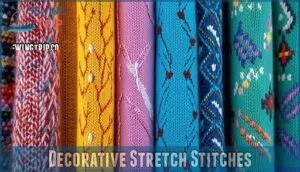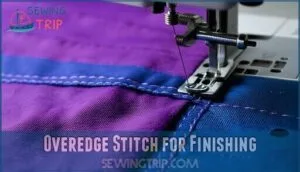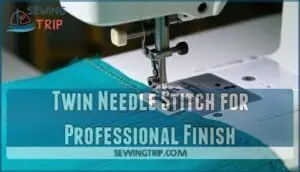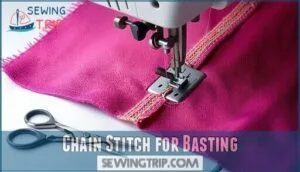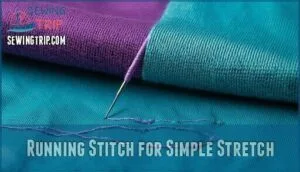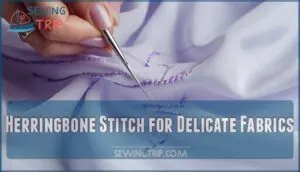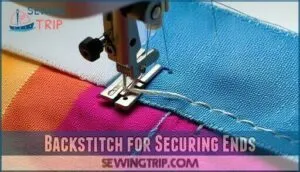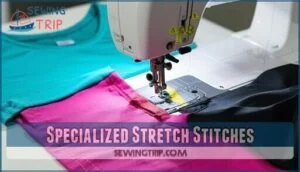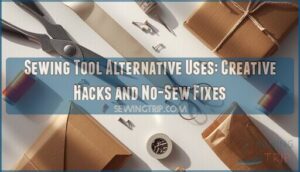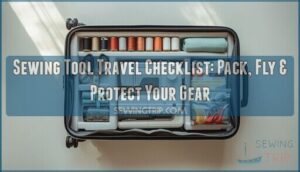This site is supported by our readers. We may earn a commission, at no cost to you, if you purchase through links.
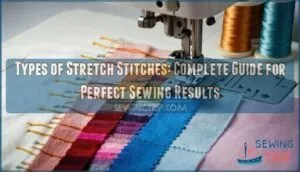
The zigzag stitch handles most stretchy fabrics with ease, while the lightning bolt stitch works magic on delicate materials.
For heavy-duty projects, you can’t beat the triple stretch stitch’s reinforced strength.
Decorative options like serpentine and honeycomb stitches add visual appeal while maintaining flexibility.
Machine stitches include the professional twin needle finish and versatile overlock for trimming edges.
Hand sewers rely on running stitches for quick fixes and herringbone for gentle fabrics.
Specialized techniques like cover stitches create store-quality hems that stretch beautifully.
Mastering when to use each stitch makes all the difference, and understanding these stitches can help you achieve a professional finish.
Table Of Contents
Key Takeaways
- You’ll master three essential basic stretch stitches – zigzag for general elasticity, lightning bolt for delicate fabrics, and triple stretch for heavy-duty projects that won’t break under stress.
- You can add visual appeal with decorative stretch stitches like serpentine, honeycomb, and feather variations that maintain fabric flexibility while creating professional-looking textures and patterns.
- You’ll achieve store-quality results using specialized machine stitches including twin needle for professional hems, overlock for trimming edges, and cover stitch for stretchy finishes that move with your body.
- You need the right needle type (ballpoint for knits), proper thread choice (polyester for flexibility), and correct tension settings to prevent puckering and ensure your stretch stitches perform optimally on different fabric weights.
Basic Stretch Stitches
You’ll find three essential stretch stitches that form the foundation of successful knit sewing: the zigzag stitch for general elasticity, the lightning bolt stitch for delicate fabrics, and the triple stretch stitch for extra strength.
These basic stitches allow your seams to move with stretchy fabrics, preventing broken threads and puckered seams that can ruin your finished garments.
Zigzag Stitch for Elasticity
The zigzag stitch stands as your go-to elastic stitch for knit fabrics and sewing stretchy fabric.
You’ll adjust stitch width to 1.5-3 and stitch length to 2.5-3.5 for ideal stretch.
Use a ballpoint needle type with proper tension settings to prevent puckering.
This fundamental stretch stitch creates flexible seams that move with your fabric, ensuring consistent fabric feed and professional results.
Lightning Bolt Stitch for Delicates
Precision meets flexibility when you master the lightning bolt stitch for delicate fabrics.
This stretch stitch type creates an upward-downward zigzag pattern that prevents puckering on knit fabrics.
You’ll need proper needle selection and tension adjustment to maintain ideal stitch density.
This is especially useful when you need a primary stretch stitch for your project.
Perfect for stretch sewing swimwear and activewear, it delivers exceptional elasticity while protecting fragile stretch fabric from distortion.
Triple Stretch Stitch for Strength
When sewing heavy fabrics like polar fleece or canvas, you’ll need the triple stitch for maximum stitch durability.
This reinforced seam creates three parallel lines that won’t snap under pressure. Industrial uses demand this robust stretch stitch for workwear and outdoor gear.
Adjust your tension settings carefully—too tight restricts stretch, too loose creates puckering in durable stretch seams.
Decorative Stretch Stitches
You’ll discover decorative stretch stitches that combine functionality with visual appeal, adding texture and design elements while maintaining fabric elasticity.
These specialized stitches, including serpentine, honeycomb, and feather variations, allow you to create professional-looking finishes that stretch with your knit fabrics.
Serpentine Stitch for Aesthetics
The serpentine stitch creates wavy patterns that add visual interest to your stretch fabric projects.
This decorative stretch stitch offers excellent fabric compatibility with knits while maintaining elasticity. You’ll find serpentine variations on most sewing machine stitches, allowing creative thread choices for unique stitch aesthetics.
Perfect project ideas include sportswear trim, children’s clothing accents, and decorative seams on activewear where stretch stitch types enhance both function and style.
Honeycomb Stitch for Texture
Beyond aesthetic appeal, honeycomb stitch creates dimensional texture that’s perfect for stretch fabrics. This decorative stretch stitch produces hexagonal patterns while maintaining fabric elasticity, making it ideal for knit fabrics and stretch materials.
Using the right stitch prevents popped stitches issues with knit fabrics.
- Honeycomb variations include dense and open patterns for different texture possibilities
- Fabric pairings work best with lightweight knits and jersey materials
- Stitch settings require adjusting width and length for superior stretch performance
- Project ideas include decorative hems, smocking effects, and textured panels
Feather Stitch for Embellishment
Delicate fabric embellishment becomes artistry with feather stitch variations that dance across your stretch materials.
This decorative stretch stitch creates beautiful branching patterns perfect for highlighting seams or adding visual interest.
You’ll find endless fabric embellishment ideas using color thread combinations that pop against your base fabric.
Hand stitching tips include maintaining consistent spacing, while machine application guides guarantee even tension throughout your decorative stitches.
Experimenting with different styles can elevate decorative quilting projects and create beautiful branching patterns with consistent spacing.
Machine Stretch Stitches
Your sewing machine offers several specialized stretch stitches that provide professional results when working with knit fabrics.
These machine-specific stitches, including overedge, twin needle, and chain stitches, streamline your sewing process while maintaining the flexibility your stretch fabrics need.
Overedge Stitch for Finishing
Your machine’s overedge stitch mimics a serger’s finishing power, creating clean edges on stretch fabric and knit fabric.
This serger alternative prevents fraying while maintaining elasticity, perfect for activewear and casual garments.
Edge durability improves substantially with this overlock stitch variation.
Industrial uses include sportswear manufacturing. For those seeking to purchase, consider an overedge stitch machine.
Various stitch variations accommodate different fabric weights and overedge applications.
Twin Needle Stitch for Professional Finish
The twin needle stitch creates two parallel straight lines on top with zigzag underneath, perfect for stretch fabric hemming.
This technique offers excellent stretchability on knit fabric while maintaining professional appearance.
Select appropriate needle width and loosen bobbin tension for best results.
Explore options for purchasing this product online.
Twin needle uses include decorative topstitching and finishing stretchy garments with clean, durable seams.
Chain Stitch for Basting
Chain stitch creates temporary seams that stretch beautifully with knit fabric.
Perfect for testing fit and adjustments before committing to permanent seams on stretchy fabrics.
This basting alternative offers quick removal when you need to adjust fit or test seam placement.
Chain stitch benefits include:
- Easy removal by pulling one thread
- Excellent stretch properties for testing
- Strong hold during fitting sessions
Adjust chain stitch tension carefully to prevent fabric puckering while maintaining adequate stretch stitch types functionality.
Hand Sewing Stretch Stitches
When you’re working without a sewing machine, you can still create flexible seams on stretch fabrics using specific hand sewing techniques.
These manual methods include the running stitch for basic elasticity, the herringbone stitch for delicate materials, and the backstitch for securing thread ends properly.
Running Stitch for Simple Stretch
You can create a basic running stitch for stretch fabric by adjusting your needle type and stitch length.
Use a ballpoint needle to prevent snags, and increase your stitch length to allow flexibility.
Thread choice matters—polyester works well for knit fabric.
Control fabric handling by avoiding excessive pulling while sewing. This simple stretch stitch technique maintains elasticity.
Herringbone Stitch for Delicate Fabrics
Herringbone stretch stitch works beautifully for delicate knit fabric where standard sewing machine options might damage fibers.
This hand application technique creates flexible seams that move with your fabric choice while maintaining seam durability. For added seam strength, consider a triple straight stitch.
Perfect your stretch sewing techniques with these essentials:
- Needle Type: Use fine needles for delicate materials
- Stitch Tension: Keep consistent pressure throughout
- Fabric Choice: Ideal for sheers and lightweight knits
- Hand Application: Sew left to right for best results
Backstitch for Securing Ends
When you finish any stretch stitch, securing your thread ends prevents unraveling that’ll ruin your hard work.
You can use backstitch variations like double backstitches or firm knots as alternatives for hand-sewing security.
These reinforcement techniques work better than standard knots with stretch fabrics.
Consider thread considerations too—polyester holds better than cotton for seams requiring flexibility and durability.
Specialized Stretch Stitches
When you’re ready to take your stretch sewing to the next level, specialized stretch stitches offer advanced techniques that professional seamstresses rely on for specific applications.
These stitches, including cover stitch, overlock stitch, and stretch straight stitch, provide targeted solutions for hemming, seam finishing, and creating garments that move with your body while maintaining their shape.
Cover Stitch for Stretchy Hems
Cover stitch machines create professional hem finishes that stretch beautifully with knit fabrics.
You’ll get that store-bought look with twin needles on top and a looper underneath.
Adjust cover stitch tension and differential feed settings for perfect results on various stretch fabric types.
One should also consider thread selection for the fabric to guarantee a quality finish.
This coverstitch technique produces stretchable seams ideal for hemming activewear and casual garments.
- Twin parallel lines of stitching visible on the garment’s right side
- Stretchy looper thread creating a zigzag pattern on the fabric’s underside
- Clean, professional finish that mimics ready-to-wear clothing construction
Overlock Stitch for Trimming Seams
Through the art of overlock stitch mastery, you’ll discover serger stretch stitch creates stretchable seams while trimming excess fabric in one pass.
Serger Applications include activewear and knits where Differential Feed prevents puckering.
Proper Tension Adjustment guarantees smooth operation, while specific Thread Types like polyester enhance durability.
Consider exploring products for this stitch to enhance your sewing capabilities.
This technique excels for stretch fabric seams requiring professional finishing without compromising elasticity.
Stretch Straight Stitch for Increased Elasticity
Unlike regular straight stitches, the stretch straight stitch incorporates built-in elasticity that moves with your knit fabric.
This flexible stitch prevents seam breakage while maintaining a clean, professional appearance on stretch fabric projects.
Essential considerations for ideal results:
- Needle Choice – Use ballpoint needles for knit compatibility
- Tension Control – Adjust thread tension to prevent puckering
- Stitch Applications – Perfect for lightweight stretch materials
- Elasticity Limits – Test fabric recovery before final sewing
Frequently Asked Questions (FAQs)
What is the best stretch stitch?
The zigzag stitch takes the crown as your go-to stretch stitch.
It’s versatile, reliable, and works beautifully on most knit fabrics.
You’ll find it balances flexibility with strength perfectly for everyday sewing.
What is a stretch stitch?
A stretch stitch is a sewing technique that allows fabric to maintain its elasticity.
You’ll use it on knit fabrics and activewear, ensuring seams stretch with the material without breaking or distorting.
What is an alternative to the stretch stitch?
Like choosing between a hammer and screwdriver, you’ve got options beyond stretch stitches. Try a narrow zigzag stitch—it’s your reliable backup that’ll flex with knit fabrics without breaking seams.
What does a triple stretch stitch look like?
You’ll see three parallel lines of stitching when you examine a triple stretch stitch closely.
This reinforced pattern creates extra strength and elasticity, making it perfect for heavy-duty stretch fabrics that need maximum durability.
What needle types work best with stretch fabrics?
Think of your needle as the key that opens the door to smooth sewing success.
You’ll want ballpoint or stretch needles for knit fabrics—they slip between fibers instead of piercing them, preventing runs and holes.
How do you prevent fabric tunneling while sewing?
Reduce presser foot pressure, use a walking foot, and select the three-step zigzag stitch. Increase stitch length to 5 or higher, and avoid pulling the fabric while sewing to prevent tunneling.
What thread types provide optimal stretch and durability?
Polyester thread offers flexibility, wooly nylon provides superior stretch, and textured nylon delivers maximum durability.
You’ll find polyester handles most projects well, while specialty threads like Maxi Lock stretch thread enhance seam strength substantially, using Maxi Lock can be beneficial.
How do you adjust machine tension for knits?
Lower your machine’s upper tension slightly from the normal setting.
Test on fabric scraps first.
You’ll know it’s right when stitches lie flat without puckering and don’t break when you gently stretch the seam.
Conclusion
Like a well-stocked toolbox, these types of stretch stitches give you the right technique for every fabric challenge.
You’ve learned that basic stitches handle everyday projects, while decorative options add visual appeal.
Machine stitches deliver professional results, and hand techniques offer gentle control for delicate materials.
Specialized stitches create durable, stretchy finishes that won’t break under stress.
With this knowledge, you’ll confidently choose the perfect stitch for your next stretchy fabric project.
- https://youtu.be/ZnVnFbOC_tk
- https://doitbetteryourself.club/blogs/sewing-tools/what-is-a-twin-needle-and-how-to-use-one?_pos=1&_sid=a7110c285&_ss=r
- https://www.youtube.com/watch?v=UuDbaeUTUXI&list=PLt8xlxgUh83oaeaVC1_0N-4GhmJ_Mlfxb&pp=gAQBiAQB
- https://madamsew.com/blogs/sewing-blog/zigzag-stitch
- https://blog.treasurie.com/stretch-stitch

